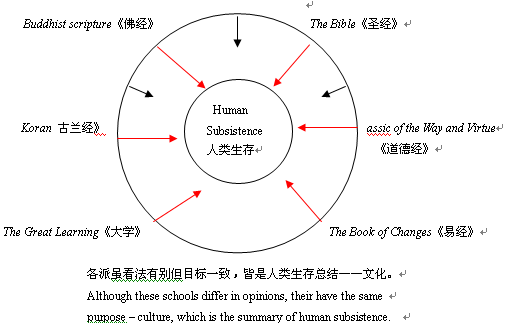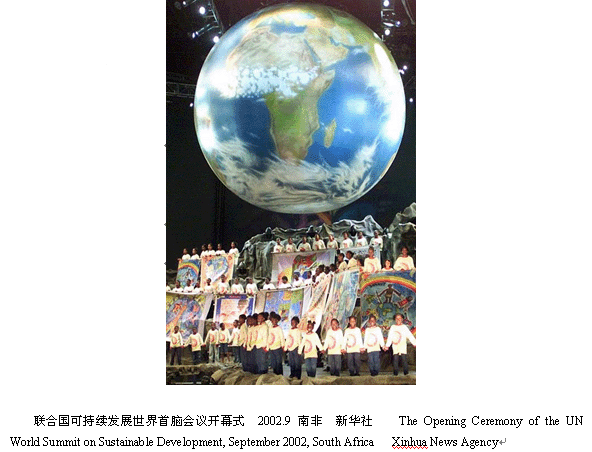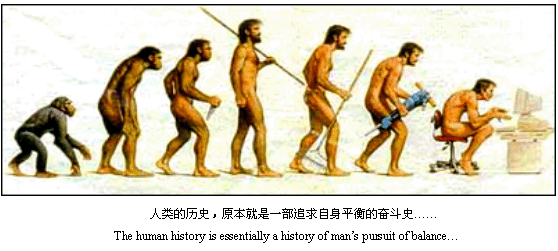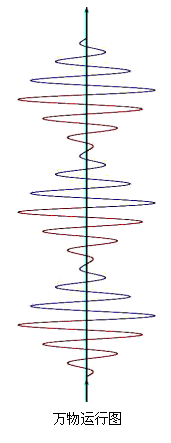九九归一,学以致用。大而化之,得意忘言。
大民主、大自由莫过于思想大解放——还思于人。
All in all, the purpose of study is application. Being too casual and carefree, one will be lost for words.
Great democracy and freedom is but emancipation of mind – let one think himself.
一、大平衡——老百姓眼中的哲学。
I. The Great Balance Theory – Philosophy in the Eyes of Common People
以往的哲学,大多是圣人说、伟人说、专家学者说。两千多年过去了,大家是否也该听听老百姓——主人翁怎么说。这是“还思于人”——21世纪的新文明,也是进一步尊重人权——尊重人的思考权的具体体现。更是人类文明新起点——大民主、大自由、大和谐的基本要求。
Philosophy in the past was mostly doctrines of sages, great men, experts or scholars. More than 2,000 years has passed, and shouldn't we hear what common people, the master of the world, think and talk about. This is to “let one think himself,” a demonstration of the new civilization in the 21st century, and the respect for human rights – more specifically, the right to think. It is also the basic requirement of great democracy, great freedom and great harmony – a new starting point of human civilization.
以往哲学较多地是在解释世界,而问题的关键更在于协调世界、保障生存。没有生存,所有问题无从谈起。
Past philosophies mostly explained the world. However, the crux is to coordinate the world and guarantee subsistence. Without subsistence, there would be no basis for any and all issues.
为了生存,人们在几千年的艰难困苦中总结了许多有形、无形的东西——文化。哲学位于文化的中心。如图:文化——人类生存的总结,哲学处于文化中心,哲学源于谋生。
For subsistence, man has summarized many tangible and intangible things in the hardships over thousands of years – culture. Philosophy is located at the center of culture. As the diagram shows, culture is the summary of human subsistence, and philosophy is at its core, as philosophy originates in livelihood.

但哲学是什么?老百姓认为:哲学就是“看法”。
But what is philosophy? Common people think that philosophy is “opinion.”
“看法”——做人、做事的根本标准、先后顺序。如《大学》讲的:本末、终始、先后。是人为“求生”对自然、社会、人及对人自身的根本看法。西方哲学即西方看法,东方哲学即东方看法。各门派哲学即各门派的看法。
“Opinion” is the fundamental criterion for and the order of priority on how to behave and how to do things. According to The Great Learning [one of the Four Confucian Classics – tr.], the fundamental and the incidental, the end and the beginning, and the early and the late, are all fundamental opinions on nature, society, man and man himself as man “seeks subsistence.” Western philosophies are Western opinions, while Eastern philosophies are Eastern opinions. Philosophy of each school is the opinion of each school.

说到底,哲学总归是“人学”,人类求生的智慧之学(智慧——合乎时宜的办法)。但“人学”总归是“人思,物理”,是人类“自己对世界”的看法,终究不是自身总是难以把握、难有切身感受。况且,即使是人“自己思量自己”,也未必就能完全说准、讲透、讲彻底。因此,世界是否确如人“思”,需要实践不断检验。
In the final analysis, philosophy is “human studies,” studies of wisdom (methods compatible with the times) for human subsistence. However, “human studies” are no more than “man thinks about matter and reason,” and are man’s opinions on the world. As it is after all not a matter of one giving opinions about himself, therefore, it is difficult for him to be sure of, difficult to comprehend thoroughly the "human studies". Besides, even if “one thinks about himself,” one may not express it accurately and thoroughly. And thus, whether the world is truly like what people “think of” should be tested constantly in practice.
“大平衡”是老百姓眼中的哲学。其研究对象是——自然、社会、人及人与自身的各自平衡及它们的相互平衡、整体平衡。力求“明确标准、找准位置、理顺关系、保障生存”。生存是目的,其余皆为手段。
The Great Balance Theory is the philosophy in the eyes of common people, which targets at the internal balance of nature, society, man and man himself, mutual balance between them and the balance of the whole. It tries to “clarify the criterion, locate the position, sort out the relationship, and guarantee subsistence.” Subsistence is the purpose while others are methods.
大平衡以中国经典哲学为基础,以自然辩证法为指导,以自然科学成果为依托,以解决现实问题为重点,以人的健康、快乐、平等、自由为目标。力求从大量存在于自然、社会及人们日常生活、工作和学习中的“平衡与不平衡”的现象中:
揭示事物发展趋向平衡的规律,探讨事物趋向自身平衡的方法,提高人类认识协调自然的能力,达到进一步推动人类文明进步之目的。
The Great Balance Theory, based on classical Chinese philosophies, guided by dialectics of nature and supported by the achievements in natural sciences, puts emphasis on solving realistic problems, to attain the ultimate goal of man’s health, happiness, equality and freedom. From numerous “balanced and unbalanced” phenomena existing in nature, society, people’s daily life, work and study, it tries to:
Disclose the law that things develop towards balance; explore methods for internal balance of things; enhance people’s capability to know nature and coordinate with it, so as to make a further progress in human civilization.
大平衡哲学的基本问题是:世界有无绝对?对它的不同回答大体分为:进步与保守两种意见。“穷则思变”、富则求稳。老百姓的目的在于:自身命运能否改变?
The fundamental problem of the Great Balance Theory is: Whether there is the absolute in the world? Answers to it can be classified into progressive and conservative ones. “Poverty gives rise to a desire for change” while wealth makes one pursue stability. The goal of common people is to change their destiny.
二、大平衡哲学产生的背景:
II. Background to the birth of the Great Balance Theory
1、时代呼唤平衡。当今世界,旧的平衡已经打破,新的平衡正在建立。但科技过快发展、物欲过分扩张、环境日渐恶化及人文的日益蜕化,都太多地冲击社会、冲击家庭、冲击个人、冲击世界、冲击自然。导致人与自然、人与人、人与自身矛盾加剧。失衡的生态、失衡的世界、残酷的竞争、脆弱的亲情和漂浮的诚信使得人们心绪浮燥、寝食难安、言行大不由衷却茫茫然不知所措。如此现状严重地影响着人们的正常生活 、工作、学习。人类的生存出现了不可持续。亟需一种理论加以协调、提示、疏理和沟通。
1. Times call for balance. In the present world, the old balance has been broken, while the new one is brewing. However, too rapid development of science and technology, excessive expansion of material desires, environmental degradation and gradual degeneration of humanities have a great impact on society, family, individual, even the world, and nature, resulting in aggravated contradictions between man and nature, person and person, and man and himself. Unbalanced ecosystem, unbalanced world, ruthless competition, fragile emotional attachment among family members, and drifting honesty make people impetuous, unable to sleep and eat peacefully, speak and do things insincerely, and they do not know what to do. Such conditions greatly influence people’s ordinary life, work and study, and human subsistence seems unsustainable; and hence comes the demand for a theory for coordination, enlightenment, readjustment and communication.
过去的100年,人类目睹了科技的进步和物质的繁荣,但同时也见证了生态的恶化与繁荣的痛楚。2005年3月30日联合国在全球8个城市同时发布的《千年生态环境评估报告》时着重指出:半个世纪以来,人类已经给自己的生存环境造成了巨大的破坏……。目前,800多个物种已经灭绝,11000多个物种濒临灭绝;40%的人面临用水短缺;每年有300万人死于空气污染造成的疾病……。
Over the past 100 years, man witnessed the progress in science and technology and thriving material life, but at the same time experienced ecological degradation and sufferings brought by prosperity. On March 30, 2005 the United Nations issued the Millennium Ecosystem Assessment Synthesis Report in eight cities around the world, underscoring that: Humankind has brought tremendous damage to its living environment… At present, more than 800 species have died out, and over 11,000 are on the verge of extinction; 40 percent of the world population is short of water; every year 3,000,000 people die of diseases caused by air pollution…

联合国2002年资料: 过去的10年中,人类失去了9400万公顷的森林,预计今后每年会有1460万公顷的森林将从地球上消失;由于人类的乱砍滥伐,全世界已有近1/4的土地变成了荒漠,100多个国家的11亿人口受到了荒漠化威胁。
As recorded in UN documents in 2002: In the past 10 years, man has lost 94 million-ha forests, and it is estimated that 14.6 million-ha forests will disappear from the earth each year. Due to man’s random felling of trees, nearly one quarter of world land has been turned to desert, and 1.1 billion people in over 100 countries have been faced with the menace of desertification.
世界卫生组织估计,环境恶化使全球可预防疾病的发病率增加了25%。过去的10年,自然灾害频频发生,给人类带来的损失高达6080亿美元,相当于此前40年的总和。作为高速发展的伴生物:环境污染、水土流失、厄尔尼诺、臭氧层空洞、海平面升高及全球气候变暖等令人不安的现象,伴随着人类走过了20世纪,又伴随着人类跨入了21世纪,成为新世纪的难题。
As estimated by the World Health Organization, environmental degradation has increased the incidence of preventable diseases around the world by 25 percent. In the past 10 years, natural disasters occurred frequently, causing a loss of US$608 billion, equal to the aggregate loss in the previous 40 years. Along with high-speed development are such disturbing phenomena as environmental pollution, soil erosion, Elnino, ozone hole, increasing sea level and global warming, which have accompanied human beings through the 20th century, and now into the 21st century as thorny problems for the new century.
2、经典文化蕴涵平衡。如 “恶有恶报,善有善报,不是不报,时辰未到”。“万物负阴而抱阳”,“天道乃损有余而补不足”。一阴一阳之谓道。佛学说:人若修福,决成正果,人若造恶,必坠地狱……;耶稣说:不要怕贫穷、饥渴,不要怕坏人的辱骂和诽谤……,因为你们会在天上得到丰厚的报偿。伊斯兰教创始人穆罕默德也曾说:“生前有过,死后必罚;今生清白,来生才会安宁”。所有这些说法,尽管门派不同,但实质内容都是“因果相应”的平衡之理。《周易》的“和”、“阴阳平衡”、老子的“道”、孔子的“中庸”、亚里士多德的“黄金中道”,巴浦洛夫的“条件反射”、黑格尔的正、反、合、“绝对理念”、马克思的“度”等等,也都是“平衡”的不同表述。
2. Cultural classics embody balance. For example, “When the time comes, evil is rewarded with evil, and good with good.” “Everything embodies Yin-Yang structure in nature.” “The Dao of Heaven reduces whatever is excessive, and supplements whatever is insufficient.” The reaction between Yin and Yang is called Dao. According to Buddhism, whoever does good deeds will eventually attain consummation and become a Buddha; while whoever does evil will fall to the hell… Jesus Christ says, do not be afraid of poverty and thirst; and do not be afraid of abuses and slanders by bad people… as you will be rewarded richly in the Heaven. Mohammed, founder of Islam, once said, “Whoever makes mistakes during his lifetime will be punished after death; whoever is clean this life will be tranquil in the next life.” All these, though of different schools of theories, have the same substance – the doctrine of balance that cause and effect are pertinent. The “harmony” and “balance of Yin and Yang” in The Book of Changes, the “Dao” by Lao Zi, the doctrine of the “mean” of Confucius, the “doctrine of the golden mean” by Aristotle, the “conditioned reflex” by Ivan Pavlov, the Thesis, Antithesis, Synthesis, and “Absolute Idea” by George Wilhelm Friedrich Hegel, and the “cross-over point” by Karl Marx, are all different expressions of “balance.”
3、自然科学支持平衡。系统论中的“自趋”概念,生态学的“自净作用”,普里高津“耗散结构论”中的“自组织”及人体的“自组织”概念。模糊数学的区域概念,协同学的“无序—有序”模型,都为大平衡“趋向自身平衡”的观点提供了科学依据。而以往能量守恒定理、新陈代谢、光电转换、电磁转换、光合作用,广义、狭义相对论、单分子、单原子理论、生命科学、细胞学说、基因学说、人择原理、测不准原理及“宇宙大爆炸”等理论,都为大平衡提供了自然科学的实证依据。
3. Natural sciences support balance. The “self-tendency” concept of systematology, the “self-purification function” of ecology, the “self-organization” concept in the “Dissipative Structure” by Ilya Prigogine and that of the human body, the Regional Concept of fuzzy mathematics, and the disorderly-orderly model of synergetics, all provide strong support for the Great Balance Theory in the idea of “self-balance tendency.” And the law of conservation of energy, metabolism, photoelectric transformation, electromagnetic transformation, photosynthesis, general and specific theories of relativity, monomolecular, monatomic theory, life science, cell theory, gene theory, anthropic principle, uncertainty principle, and the theory of “cosmic explosion” are all concrete evidences of natural sciences for the Great Balance Theory.
其实,各门学科就都是一个个具体的行业平衡论。
Actually, each subject is a specific professional balance theory.
“大平衡”哲学就这样应运而生。但我们只作推荐、不求人愿,只把它当作“哲学超市”中的一个新品牌。希望它是令人快乐的哲学。
The Great Balance philosophy thus came into being as demanded by the times. We just recommend it as a new brand in the “supermarket of philosophies,” but will not force it on people. We hope it will make people relax, happy and comfortable.
三、哲学象一副“眼镜”。眼镜不同看法不同、角度不同看法不同。看法决定做法。人们所说的“意识形态”,乃是各政治派别、利益集团对世界的“看法”。由于角度不同、利益不同、时代所限等等,其看法都难免有所偏颇。
III. Philosophy is like a pair of “glasses.” With different glasses, just as from different perspectives, people have different opinions. Opinions determine the way of doing things. The “ideology” people talk about is opinions about the world by various political sects and interest groups. Due to different perspective and interests, and the limit of the times, their opinions are more or less biased.
历史证明,马克思主义的确是一个伟大的理论。它给古老的中华文明注入了蓬勃的活力,使得中国人民有了与世界同步的新式思维、有了新中国、有了中国今天的改革、繁荣与稳定。而且,马克思主义还影响了全世界。但一个理论再伟大也不可能包办所有。马克思主义也受时代局限而不可能完美无缺。这是正常现象也是科学态度。但只要坚持马克思主义“服务大众”的基本理念、基本目标,并由马克思主义者起带头,首先将它尽可能多地落到实处,就是真正地坚持了马克思主义。至于具体方法如马克思的“传承创新、依托科技、大气恢宏、针砭时弊”等,则是:具体问题具体分析、与时俱进、相机而行。而不是什么时候都教条地按照其篇章字句“一刀切”下,或因过分“维护”而过犹不及。更应注意的是,坚持马克思主义与吸纳其它文明经典并不矛盾而是相辅相成。因为,能在历史上形成影响、发挥作用的团体、派别、政党的看法、理论、主义、主张都各有优胜,都是人类生存的共同财富。
History has proven that Marxism is a great theory. It has brought vitality for ancient Chinese civilization and new thinking synchronizing with the world for the Chinese people, and hence the New China was founded, and then come the reform, prosperity and stability of China today. Furthermore, Marxism has a great influence on the international community. But, however great a theory is, it cannot embody all, and Marxism is not without flaws as limited by the times. This is a normal phenomenon and also out of a scientific attitude. As long as we hold the basic idea and purpose of Marxism to “serve the people,” and put it into practice as much as possible, with Marxists taking the initiative, it is true adherence to Marxism. As for specific methods such as “inheritance and innovation, dependence on science and technology, of great momentum, and criticism on social evils” of Karl Marx, we should: make specific analysis for concrete problems, keep abreast with the times, and act as the occasion demands; and should not use a single solution for all problems without considering the circumstances, or “defend” it too much since going beyond is as wrong as falling short. More noticeably, adherence to Marxism and absorbing cream of other civilizations supplement each other, rather than conflict with each other. All opinions, theories, doctrines and views of groups, schools of theories and political parties, which have been influential and played a role in history, have their unique advantages, and together they make the common wealth for human subsistence.
时至今日,哲学大体归纳了三种生存模式:
实用主义——先讲目的、再讲方法;(本能求“生”)
适用主义——既讲目的、又讲方法;(理性求“生”)君子爱财、当取正道。
大同主义——共同发展、主讲和谐。(自然共“生”)
By now, philosophy has summarized by and large three modes of subsistence in general:
Pragmatism: It puts purpose at the first place, then method. (To seek subsistence by instinct.)
Doctrine of Applicability: It emphasizes both purpose and method. (To seek subsistence by reason.) Gentlemen love wealth, but should get it in a righteous way.
Universal Harmony: It pursues common development, with harmony at the core. (For common subsistence in nature.)
以上三种模式的目的都是“生存”,人们一般都在其中相机选用,较难分出高低上下。实际上,无论那种主义只要利于生存,适当、适宜、适用,就都是好主义。
The purpose of the above three is to “subsist.” Usually people choose one of the three according to circumstances. They cannot be differentiated as superior or inferior. In fact, whichever doctrine to choose, it is a good doctrine as long as it helps subsistence, is suitable, appropriate and applicable.
东西方哲学各有所长、亦有所短。大平衡将尽学其长亦考其短。世事发展周而复始,今日长明日未必长,今日短明日未必短。利于生存、百姓认可、相机选用乃为上策。唯变、唯适、唯宜,唯百姓满意、唯真理追求、唯生生不息为准。
Western and Eastern philosophies have their strong points as well as weaknesses. The Great Balance Theory will try to absorb all strong points while taking into consideration their weaknesses. Everything develops in a circle. It is good today but perhaps no long good tomorrow; it is weak today but perhaps no longer weak tomorrow. The best is the one that helps subsistence, is recognized by people and is chosen for use according to circumstances. The criterion is one that is changing, suitable, appropriate, satisfactory to common people, pursues truth, and develops unceasingly.
吾爱吾师、爱真理、尤爱生生不息。因此,大平衡与各学派将奉行:“尊重理解、学习借鉴”的和谐原则。
I love my teacher, truth, and especially endless development. And thus, the Great Balance Theory and other schools uphold the principle of harmony to “respect and be understanding, learn and borrow experience.”
在老百姓看来,无论何种派别、团体、政党、理论,判断他们的标准只有一个,那就是:整体利益有序增减。只要符合这个标准、只要老百姓满意,一般都是好主义。
In the eyes of common people, regardless of school, group, political party or theory, there is only one criterion when judging them. That is, orderly increase or decrease of overall interests. As long as the doctrine meets the criterion, and is satisfactory to common people, it usually is a good doctrine.
四、大平衡主张:
IV. Views of the Great Balance Theory
1、内容通俗——提倡哲学的“研究与普及”适当区分。争取让人感到:哲学就在咱们身边,就在咱的吃、穿、住、行、用之中。
1. Plain in content. It advocates appropriate separation of the “research and popularization” of philosophy, trying to make people feel that philosophy is around us, present in our food, clothing, housing, transport and use.
2、方法简洁——提示大家更新、把握“平衡”概念,提供简洁、高效及颇具人性的平衡方法,让人感到得心应手、春意融融。
2. Simple in method. It prompts people to update and grasp the idea of “balance,” and provides simple, efficient and humane methods, making people feel easy to handle and comfortable.
3、效果明显——力争促进人与自然、社会、人及人与自身“相辅相成、相反相成、良性循环、有序攀升”,促进“整体利益有序增长”。
3. Obvious in effect. It tries to promote the relationship between man and nature, society, man and man itself to “supplement each other, oppose yet complement each other, go in a virtuous circle, and grow in an orderly way,” and also the “orderly increase of overall interests.”
中国《易传》讲“乾以易知,坤以简能。易则易知,简则易从。……。易简而天下之理得矣。”世界再复杂无非是矛盾,宇宙再复杂无非是阴阳,计算机再复杂也无非是0和1的排列。
The Record of Changes in China also says, “Qian (heaven) can be known through changes, while Kun (earth) is capable through simplicity. Changes can be known through changes, while simplicity comes from changes… Change and simplicity is the principle of the world.” However complex the world is, it is no more than contradiction; however complex the cosmos is, it is no more than Yin and Yang; and however complex the computer is, it is no more than sequence of 0 and 1.
五、大平衡的理论基石:相对论——世事无绝对。(矛盾互根、相对、辨证、统一)
V. Theoretical foundation of the Great Balance Theory – the Theory of Relativity, which holds that everything is not absolute. (Each of the two aspects of contradiction is rooted in each other, relative, and dialectical, and unitary.)
哲学本身就是一个相对性的学问。大平衡认为,运动也是相对的,只是相对的形式不同而已。人们在研究“动”时,以人“内心”的“静”为其参照、与其相对。虽然这个“静”也在“动”,但“静为动根”,这个“动着”的“静”却必须“存在”方能显示“动”。否则就没有“动”。我们认为,这个相对动的“静”就是人们常说的“形而上”的那个东西。说它有看不到、说它无它却在,无它无“动”。没有“形而上”也就没有“形而下”。但这个“形而上”的东西,却如古人所讲:变动不居、周“溜”六虚。
Philosophy itself is a learning about relativity. The Great Balance Theory holds that motion is also relative, though the form of the opposites is different. When people study “motion,” they take “stillness” in people’s “heart” as an object of reference, so “stillness” serves as an opposite of the “motion”. Although such “stillness” is also “moving,” “stillness is rooted in movement,” and the “moving stillness” must “exist” to show its “motion.” Otherwise there will be no “motion.” This “stillness” in a relative way is what people call “metaphysical.” We say it exists, but we cannot see it; we say it does not exist, but it does exits. Without “metaphysics” there will not be physics. However, as ancient men said, “metaphysics” is always changing, “flowing” in six directions.
“绝对论”的“神”也是相对的。如果没有“万物”与“神”相对,也就没有谁知道“神”。现实中也不存在“绝对”的事情。如果穷人的儿子永远是穷人,富人的儿子永远是富人,法官的儿子永远是法官,人间万事永不再变,穷人没有半点希望,那他们也就不想活了……。世界也将不复存在。
The “god” in the Theory of the Absolutism is also relative. If there are no “things on earth” opposite to “god,” then nobody knows about “god.” And in reality there are no absolute things. If sons of the poor are always poor, those of the rich are always rich, those of judges are always judges, and nothing changes in the world, then the poor won’t have any hope and would prefer not to live… And the world would not exist.
古人讲,孤阴不生、独阳不长。有斯必有对。世上没有绝对的东西,只有相对的东西。只是这“相对”的形式千差万别、变动不居、难以概括表述。而“平衡”则是既可概括表述、又可与万物个个相对、还能与万物同处“和二为一”,是万物生、长、成、老、转化之理。“平衡”这种独有的“虚实”功用,决定了它最有资格担当宇宙本原。
As ancient men said, Yin cannot exist without Yang, and Yang cannot grow without Yin. One exists, and the opposite shall exist. There is nothing absolute in the world; instead, relative. Forms of the “relative” vary greatly and are always changing, and cannot be generalized. While “balance” can generalize and express them, be the opposite of all things on earth, and “combine into one” with all things, becoming the law of birth, growth, maturity, aging and transformation of all things. Such a unique function of “balance” determines that balance is most qualified to be first principle of the cosmos.
研究大平衡应注意:(1)深化更新平衡概念。(2)平衡源于斗争。和谐为主、斗争为辅、适时而定。(3)只作推荐、不求人愿。
When studying the Great Balance Theory, we must pay attention to: (1) Deepen and update the idea of balance; (2) Balance originates in conflict, with harmony as the major aspect, conflict as the supplementary. (3) We only recommend it, but will not force it upon people.
总之,大平衡是一个永远开放的理论,它将源源不断汲取古今人类智慧,不断地修正、完善、补充自己,并与时代同步加强针对性研究。而无需多议它是何种宗教、神学、哲学、自然科学还是其它什么门派、学说。只要有利于“整体利益有序增长”,大平衡将与时俱进一并吸纳、整合、改造、择优选用,绝无门户之见也永远不会完结。
In summary, the Great Balance Theory is always an open theory. It will continuously absorb man’s wisdom in ancient and present times, revise, improve and supplement itself, and strengthen studies with a clear aim in abreast with the times, and there is no need to discuss which school of religion, theology, philosophy, natural sciences or other school or doctrine it belongs to. The Great Balance Theory will keep in abreast with the times to absorb, integrate, transform, and select from those helping the “orderly increase of overall interest,” and continue the process without bias forever.
其实,人类的哲学,早就应该是这个样子。
Actually, such should have been human philosophy long ago.

思路决定出路,看法决定做法,作为决定地位,境界决定人生。——李继兴
The way of thinking determines the way out, opinion determines method, accomplishment determines status, and the spiritual realm determines life. —— Li Jixing
|

